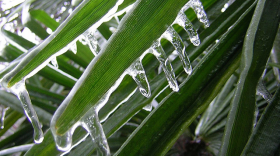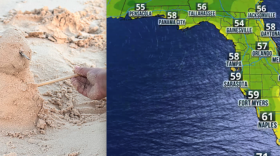As Earth's thermostat rises, the places where certain plants grow best are shifting north — but most farmers and gardeners don't need to uproot their routines just yet.
The U.S. Department of Agriculture updated its map of growing zones relied on by millions of farmers and gardeners nationwide to determine if they remain within the viability zone for their variety of crops or plants.
The USDA’s Plant Hardiness Zone Map is used by at least 80 million farmers and gardeners, and the newest version is more accurate and filled with greater detail than the last guidance published a dozen years ago.

There are 13 zones, spanning ten degrees each, from Key West to northern Alaska. Which perennials should survive cold snaps in any given zone is determined by the lowest temperature averaged over many years, which provides a benchmark for crops and plants of all types.
Perhaps unfamiliar to those who are not farmers or household gardening aficionados, the USDA's growing zone map is well known to those who are. The recent shifts in the growing zones have significant implications for growers, whether food on a 5,000-acre farm or flowers hanging in planters on the front porch.
“When I first started, I studied that thing like the back of my hand,” said Steve Cucura, owner of Fruitscapes in Bokeelia, who relied on the hardiness map to figure out where to plant his tropical fruit tree farm. “I used that map very thoroughly when I started looking for property and it led me on a hunt throughout the state. I settled on Pine Island and that's where I am today.”
Decades later, Fruitscapes is flourishing with fruit trees, shrubs, and vines available worldwide.
The USDA used average winter lows during the past 30 years to create the 10-degree growing zones as well as 5-degree half-zones, adjusting the swaths to where perennials are most likely to thrive.
The new map released late last year shows half of the nation logged average low temperatures up to 5 degrees warmer than the last time the department updated the growing zones in 2012.
Much of Southwest Florida increased by more than 5 degrees including Bokeelia, where in recent years Cucura has been able to start growing breadfruit, a versatile and nutritious food source often prepared in ways similar to potatoes.

Cucura, who keeps a USDA guidance map handy to help his customers nationwide decide which trees and plants will thrive where they are, is not growing crazy with new varieties because he said no matter what the guidelines say, any given winter's cold snap could be far below the averages used by the USDA.
“I haven't really looked at the newest map because I know the weather patterns and am familiar with what happens here on Pine Island,” he said. “But it is a good reference for somebody who wants to start off.”
Don’t panic
The updates to the USDA growing zones provide more accurate guidelines for selecting appropriate plants, ensuring healthier growth, better yields, and serve as a guide for agricultural planning, landscaping, and environmental conservation.
The implications for Southwest Florida, with its newly defined zones, include increased opportunities for cultivating a variety of tropical plants and a potential shift in agricultural practices to adapt to the warmer climate.
The agency’s effort received more than a little publicity from National Public Radio through a slide show.
For all of the time, effort, and technology that goes into the hardiness zone map, in simple terms, it's a measure of a plant’s cold tolerance to help growers feel comfortable that they have chosen plants that can withstand the winter where they live.
There are about 1.8 million acres of farmland in Southwest Florida, according to the USDA and the Florida Department of Agriculture & Consumer Services. Top crops include citrus, vegetables such as tomatoes and bell peppers, and sugar cane.
The USDA cautions that a shift in a particular zone does not mean most growers within it should panic and change what they cultivate.
That’s because the zones are based on an average of the coldest yearly temperature over decades, not the lowest temperature ever – nor does being in a zone guarantee its low will not be crossed.
Other environmental factors can cause the success, or failure, of crops and gardens including winds, soil type and moisture content, humidity, rain or snow, and winter sunshine can greatly affect the survival of plants.
How plants are placed and spaced, their size and health, and pollution in the air or soil can also affect their chances of survival.
“If your hardiness zone has changed in this edition of the USDA Plant Hardiness Zone Map, it does not mean you should start removing plants from your garden or change what you are growing,” the USDA wrote. “What has thrived in your yard will most likely continue to thrive.”
Tell that to Florida’s strawberry growers.
Get moving
Last year, research by the University of Florida and Environmental Defense Fund found global warming will chase Tampa Bay-based strawberry growers north by 2050 – little more than 25 years from now - to be in the proper growing zone.

Rising temperatures, lack of water, unpredictable weather events, and changes in sunlight are already affecting crop yields, farming practices, and the availability of strawberries.
Their report said the price to pay for not moving is a 17 percent decline in early yields, which means growers will earn 10 percent less per acre at the start of harvesting season.
In Hillsborough County, which is home to the City of Tampa and where most of the state’s strawberries are raised, growers who decide to stay put when the time comes need to plan for an overall decline in production of 11 percent.
“Agriculture has been hard hit by extreme weather in Florida especially, sustaining over one billion in losses from Hurricane Ian in 2022 alone,” said Dawn Shirreffs, the Environmental Defense Fund’s Florida director. “Mid-century climate change will have a big impact on farmers who are growing these delicious red fruits.”
New opportunities
Florida's diverse climate, influenced by its subtropical and tropical zones, makes it particularly sensitive to changes in growing conditions, which in this case is not all bad things.
The changes in South Florida’s hardiness zones portend a more diverse array of crops that can be cultivated and with that the potential for significant economic benefits.
Among the improvements:
- Increased accuracy and detail. The map incorporates data from 13,412 weather stations, compared to 7,983 used for the 2012 map, leading to more precise zone designations
- More sophisticated mapping techniques and technology create a more accurate and detailed map
- Improved resolution for Alaska, going from a more than six-square-mile area of detail to a quarter-square mile
- A new "Tips for Growers" section on the website provides information about research programs of interest to gardeners and plant growers
- An interactive format that is user-friendly and designed to work well on the internet
- The ability to quickly find plant hardiness zones by entering a zip code or clicking on the map.
Long known as a producer of citrus, tomatoes, strawberries, and various vegetables, Florida’s shift in zones to warmer temperatures opens up new possibilities for tropical fruits like mangoes, papayas, avocados, and guavas.
Such fruits require consistently warm temperatures. With little chance of a hard freeze reaching South Florida, farmers should be able to grow tropical fruits reliably.
Gardeners can plant a wider array of ornamentals such as tropical palms, bromeliads, orchids, and other heat-loving plants that were once considered too risky to grow outside instead of inside.
Landscapers, too, can now feel comfortable trying once risky plants, which can give them new and nifty ways to beautify gardens and public spaces as well as the use of species that contribute more diversity in the environment.
The expansion of suitable growing zones for high-value tropical crops can have significant economic benefits for Florida. Farmers can diversify their crops, potentially increasing their income and contributing to the state's economy.
The horticultural industry may see growth as the demand for ornamental plants grows.
However, not everything is peachy. There are increased costs in ensuring a sustainable water supply for the additional crops, and new pests and diseases come with warmer temperatures.
“Florida’s agriculture has a long history of successful adaptations to the vagaries of weather and climte,” wrote researchers involved in the book "Florida's Climate: Changes, Variations, and Impacts".
“Additional increases in future temperatures will lead to lower crop yields, creating challenges to the competitiveness of current production systems. Crop growth and productivity, as well as the occurrence of pests and diseases, are all influenced by climate factors.”
Farmers and gardeners are not the only ones paying attention to the changes. The USDA’s Risk Management Agency refers to the map’s plant hardiness zone designations to set certain crop insurance standards. Scientists incorporate the plant hardiness zones as a data layer in many research models, such as those modeling the spread of exotic weeds and insects.

Not a climate change tool
The USDA said temperature updates to plant hardiness zones are not necessarily reflective of global climate change.
In other words, the map can give some insight into shifting climate patterns and potential impacts of climate change on plant habitats, but don’t go there because changes in the planet’s overall climate are far more complex than just changes in low temperatures.
The people who redesigned the map also said other factors are in play, including that the low temperature of any one location can vary quite a bit, the inclusion of data from so many more weather stations, and the use of more sophisticated mapping.

“Map developers involved in the project cautioned against attributing temperature updates made to some zones as reliable and accurate indicators of global climate change, which is usually based on trends in overall average temperatures recorded over long time periods,” a USDA statement on the new map said.
However, the international nonprofit Arbor Day Foundation teamed with Davey Tree Expert Company to add data global warming data to the USDA hardiness map to create another map showing plant hardiness zones from 1980 through 2099.
“This map helps homeowners visualize how a warming climate will determine which trees and plants will thrive in their neighborhoods,” Dan Lambe, the Arbor Day Foundation’s top executive, told WUSF Public Media last year. “And it really is not a planting guide as much as it's a reminder for people that climate change is here, and we've got to be ready.”
Like the USDA’s heartiness zones, the Arbor Day Foundation’s heartiness map is searchable by zip code so those interested can see not only if the two maps differ but, if so, in which direction and by how many degrees.
"If we're going to invest the time, and if we're going to invest the money in planting trees, we want to make sure those trees survive and thrive,” Lambe said. “And so, we're helping people be thoughtful about what they're planting today that can live and thrive for decades to come.”
Dan Herms, a Davey Tree vice president, said the combined map shows tree species that grow as far south as northern Florida are at risk. WUSF reported rare species in danger of extinction in the state including the Florida Torreya: a rare glacial relic, and Florida
orkwood: a rare colony-forming shrub in coastal wet areas of northern Florida.
Like mangroves and other bushes and trees, the species may be able to thrive as they follow their viability zones as global warming continues to push them north.
“In general, species are most vulnerable to climate change at the southern limits of their distribution where they experience most stress from heat,” Herms said. “At the northern range of their distribution, they have the potential to migrate farther north as climate changes.”
Opinions vary
When tens of millions of people assess the same thing, opinions will vary. The latest version of the USDA heartiness map is no exception.
The American Horticultural Society, climate scientists, and agricultural extension services, in general, praise the new version for its increased accuracy and view it as a valuable tool for adapting to changing climate conditions.
The groups appreciate the map's role in helping gardeners and farmers make informed decisions about plant selection and landscape management.
Some small-scale farmers and gardeners express skepticism, concerned that the map's reliance on long-term averages may not adequately account for extreme weather events. Climate skeptics question the map's implicit acknowledgment of global warming, arguing that other factors should be considered more prominently.
Local and regional farmers' associations have raised concerns about the practical implications of shifting to warmer zones. They worry that this change might encourage planting crops that are not yet reliably sustainable in their areas, potentially leading to economic losses.
The groups advocate for a more cautious approach that emphasizes localized knowledge and experience.
Ecologists and conservationists, while generally supportive of climate adaptation strategies, caution about the potential impact on native plant species and ecosystems.
They warn that introducing new plant species into warmer zones could disrupt local biodiversity and lead to unforeseen ecological consequences.
The groups call for a balanced approach that considers the preservation of native habitats alongside agricultural interests.
While millions of farmers do rely on the USDA's growing map to guide them one farmer in Lorida, Florida, doesn't care for the USDA’s growing zone map.
“I’m aware of it, but I don’t need it,” said Frank Regan, owner of Orange Lake Nursery in Lorida, Florida. “All my plants are indoors.”
Sign up for WGCU's monthly environmental newsletter, the Green Flash, today.
WGCU is your trusted source for news and information in Southwest Florida. We are a nonprofit public service, and your support is more critical than ever. Keep public media strong and donate now. Thank you.

















